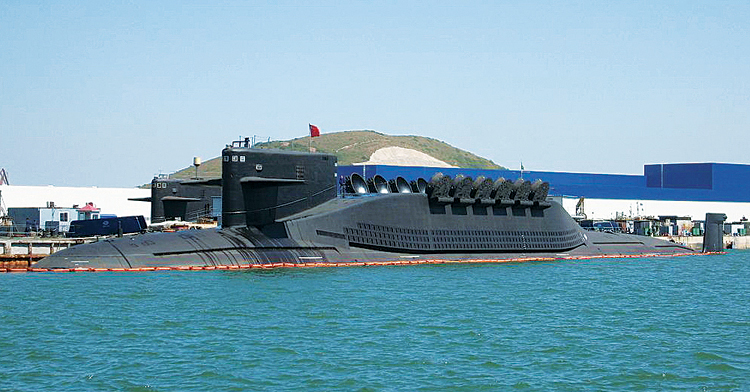INDIAN ARMED FORCES CHIEFS ON
OUR RELENTLESS AND FOCUSED PUBLISHING EFFORTS

SP Guide Publications puts forth a well compiled articulation of issues, pursuits and accomplishments of the Indian Army, over the years

I am confident that SP Guide Publications would continue to inform, inspire and influence.

My compliments to SP Guide Publications for informative and credible reportage on contemporary aerospace issues over the past six decades.
LEAD STORY
Unseen & Unheard: The Role of Stealth
Evolving Submarine Stealth Technologies ensure a Lethal Silence for the Sentinels of the Deep
 | The Author was the Flag Officer Commanding-in-Chief, Southern Naval Command when he retired on November 30, 2021. He is a Navigation and Direction specialist. He was also the Director General Naval Operations and the Chief of Personnel, Indian Navy. |

Naval submarines were invented to exploit the opaqueness of the underwater domain, which gave them an asymmetric advantage over much larger, faster and better armed surface vessels. While submarines require several attributes to be successful in their assigned roles and missions, the most important attribute for their success is stealth. The reason for this is their vulnerability to attack by surface, subsurface or aerial platforms once detected. Submarines are, therefore, designed with stealth in mind and submarine stealth technology has been one of the most researched and protected of all technologies, always remaining a step ahead of anti-submarine warfare capabilities.
Approach to Submarine Stealth
It is important to keep in mind that a submarine’s stealth cannot be viewed in isolation and requires a “whole of systems” approach. Towards this, stealth technologies can be broadly divided into two broad categories – acoustic stealth and non-acoustic stealth. Improving acoustic stealth requires addressing both the acoustic energy created by a submarine’s passage underwater and the acoustic energy reflected by the submarine from its adversary’s active sonar transmissions. On the other hand, non-acoustic stealth of a submarine includes aspects such as its radar signature, vulnerability to visual and infrared detection, electromagnetic signatures, underwater endurance, etc. Stealth engineering is, therefore, essential in every aspect of a submarine – be it its hull shape, its hull surface, its main and auxiliary machinery, its external communication equipment, and its sensors and weapons. Key aspects of a submarine’s acoustic and non-acoustic stealth are examined briefly in subsequent paragraphs.
Acoustic Stealth
The shape of submarine hulls, appendages and their propellers is the first and most important aspect of a submarines stealth capability. Initially, submarine hulls were not very stealth-oriented, and hence were easier to detect. As stealth technology progressed, modern submarines hulls became much more streamlined, being designed empirically, with their drag coefficient through water being obtained through simulation using computational fluid dynamics (CFD). Modern-day submarine design has graduated to use of sophisticated computerised optimisation algorithms, which have further reduced their flow resistance, and thereby their acoustic signature as they move underwater. Double-hull construction is another method to streamline a submarine’s shape, which aims to achieve acoustic quietening from the outside inwards, rather than quietening individual equipment. Technologies to give a more hydrodynamic shape to the submarine propeller(s) as also their physical composition are also constantly evolving. New developments in this field include “integrated propulsors”, “polymer ejection” and “electromagnetic turbulence control”.
As far as submarine hull surfaces are concerned, submarines of the Second World War era had metal hulls, similar to warships, which gave a very good return signal to a sonar sound pulse, and were therefore easy to detect and attack. The invention of hull coatings of various types, such as anechoic tiles, which were stuck to the surface of a submarine’s hull, considerably dampened the acoustic energy produced and reflected by a submarine, while also reducing the flow-generated noise produced by a submarine. In the cat-and-mouse-game between submarines and surface ships, the development of modern low frequency sonars considerably nullified the advantage of even the best designed anechoic tiles. The latest development in stealth technology for submarine hull surfaces is the invention of “active tiles” based on “giant magnetostrictive material” (GMM) technology, that gives a return echo of a different frequency, to confuse the sonar operator on a surface ship.
Advancements in stealth technology have empowered naval submarines to operate covertly, gaining an edge over surface vessels
A major source of the total noise generated by a submarine is its main engines and various auxiliary machineries (especially pumps and motors) fitted on a submarine. A principal focus of a submarine’s noise reduction has consequently been the design of the mountings of all rotating or moving machinery, besides quietening the design of the machinery itself. Starting with basic rubber mountings, these have now graduated to mountings using piezoelectric materials or other types of actuators to actively cancel mechanical vibrations generated by the machinery, and hence reduce underwater noise. “Raft mountings” and “isolated structures” within a submarine are also being used to reduce acoustic signatures further. Software-based condition-based monitoring (CBM) systems, which can centrally and continuously monitor all on board machinery for various parameters including vibrations, have also become an integral part of a submarine’s systems.
Air-Independent Propulsion (AIP) and other Technologies
A major restriction in maintaining stealth for conventional submarines is the fact that they require to surface periodically to “snort” and charge their batteries. In modern conventional submarines this restriction has been largely overcome through the introduction of air-independent propulsion (AIP), which increases the underwater endurance and reduces the acoustic signature of submarines. However, even conventional submarines fitted with AIP have limitations, both to their maximum sustained underwater speed and their endurance, prior needing to surface or snort to charge their batteries. Thus, the ongoing research into the development of better and safer AIP fuel cell systems is synonymous with enhancing the stealth capability of modern submarines.

Stealth technology is also required to be incorporated into a submarine’s weapon and communication systems to ensure that they do not significantly enhance a submarines acoustic and radar signature while being used on the surface or underwater. As far as weapons systems are concerned, “weapon launch transient noise silencing” is necessary to quieten both torpedo and missile handling and launch systems to ensure a submarine’s survivability in the critical period during and after its weapons launch. Similarly, both satellite and trailed wire communication antennae systems of submarines, which are essential capabilities for effective achievement of a submarine’s missions, also require quietening. Conversely, the lesser a submarine’s own acoustic signature, the better will be the capability of its own sensors to detect surface ships and submarines. The design of sensors itself, such as sonar sensors embedded on a submarine’s hull, instead of a large bow mounted sonar, are new methods to reduce the acoustic signature of submarines by making their hull more streamlined. The most recent development in this field is the introduction of “off-board vehicles” to extend a submarine’s reach and enhance its stealth.
A Stealth-Enabled Future
As would be evident, a range of technologies and materials go into making a submarine quieter, which require extensive R&D. Developments in this field are constantly evolving and given the advances, not only in anti-submarine detection capability, but also in global surveillance capabilities, submarines not possessing adequate stealth capability will not survive against a better armed adversary. With the submarine arm being an indispensable part of India’s tactical and operational warfighting strategy, as also it’s second-strike and strategic deterrence capability, we needs to focus on investments in the field of underwater stealth, especially CFD and non-acoustic modelling, to ensure that our submarine arm remains a potent weapon and a deterrent against possible adversaries.





